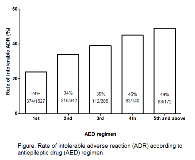Tolerability of Antiepileptic Drugs in Patients With Newly Diagnosed Epilepsy: A 30-Year Longitudinal Cohort Study
Abstract number :
2.275
Submission category :
7. Antiepileptic Drugs / 7D. Drug Side Effects
Year :
2018
Submission ID :
505411
Source :
www.aesnet.org
Presentation date :
12/2/2018 4:04:48 PM
Published date :
Nov 5, 2018, 18:00 PM
Authors :
Bshra Alsfouk, University of Glasgow; Martin Brodie, University of Glasgow; Matthew Walters, University of Glasgow; Patrick Kwan, University of Melbourne, The Royal Melbourne Hospital; and Zhibin Chen, University of Melbourne
Rationale: Despite the increasing use of many new antiepileptic drugs (AEDs) with differing mechanisms of action, our previous study demonstrated overall unchanged seizure outcome in newly diagnosed epilepsy over the past two decades. However, the long-term tolerability profile of AED therapy is not well studied. Here, we analysed the profile of AED-induced adverse drug reactions (ADRs) over a 30-year period. Methods: Adults who were newly treated with AEDs at the Epilepsy Unit of the Western Infirmary in Glasgow, Scotland between 1 July 1982 and 31 October 2012 were included. All patients were prospectively followed till 30 April 2016 or death. ADRs reported by the patients were systematically reviewed and categorized into Medical Dictionary for Regulatory Activities. ADRs that led to the discontinuation of the AED were defined as intolerable. Results: A total of 1527 patients were included (56% male, median age 37 years, range 18-93). They tried a total of 2766 AED regimens, including 2028 (73%) as monotherapy and 738 (27%) combination therapy. Among the monotherapies, 927 (46%) were established AEDs and 1101 (54%) were newer AEDs.675 (44%) patients reported various degrees of ADRs, including nervous system disorders (e.g. tremor, sedation and headaches) by 391 (26%), general disorders (e.g. fatigue, ataxia and irritability) by 272 (18%), and psychiatric disorders (e.g. aggression, depression and mood swings) by 136 (9%).498 (33%) patients had at least one intolerable ADR. When taken as monotherapy, established and newer AEDs had similar rate of intolerable ADR (OR=1.09, 95% CI: 0.88-1.36, p=0.44).The crude rate of intolerable ADR appeared to increase for each additional AED regimen tried (Figure). Upon multivariable analysis, females were more likely to report intolerable ADR than males. Compared to monotherapy, patients taking 2 AEDs had 1.67 times the odds to develop intolerable ADR after adjusted for number of previous AED regimen tried, previous intolerable ADR, age, gender, pretreatment psychiatric comorbidity and epilepsy type (Table). The odds increased further in those on 3 (odds ratio [OR]=2.38) and 4 (OR=5.24) AEDs. Patients who had intolerable ADR to previous AED regimen(s) had much greater odds to experience a further event (OR=22.7). After considering all the above factors, the odds of intolerable ADR actually decreased for each additional AED regimen.When analysing the 642 patients who took more than 1 AED regimen, those who failed the first AED due to ADRs were more likely to develop intolerable ADRs to subsequent regimens (OR 5.09, 95% CI: 3.96-6.54, p<0.001). The odds of drug withdrawal due to ADR increased by 12 folds for each additional previous intolerable ADR (OR=13.3; 95% CI: 9.7-18.1; p<0.001). Conclusions: One-third of patients had discontinued AEDs due to ADRs. Overall, the established and newer AEDs had same tolerability rate. Number of concomitant AEDs significantly reduced tolerability. A history of intolerable ADR had great impact on the tolerability of future regimens. Patients tended to have better tolerance to AED over the course of treatment if no previous intolerable ADR or no concomitant AED was introduced. Funding: Not applicable

.tmb-.png?Culture=en&sfvrsn=ef5a8293_0)